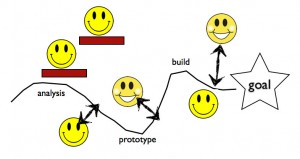Ah. Adventure Maps. Away with spreadsheets, checklists and grid prisons.
Bring on your crayons!
A highly playful, interactive and intuitive way of communicating complex elements in your project. Or just an excuse to go overboard on the lame jokes and awkward analogies.
I find it to do wonders for stakeholder analysis.
Stakeholder analysis is a technique to identify and analyze the stakeholders surrounding a project. It provides information on stakeholders and their relationships and expectations. A proper analysis of the stakeholders will help you to construct a project approach suited to the situation and will allow you to negotiate better with the stakeholders.
It works like this (you can click on the image to enlarge).
Invite some relevant people to brainstorm the stakeholder map. Get a whiteboard. This can be an old fashioned one, you know the kind you put on a wall. Or this can be an online version for remote organizations.
Draw an image of the goal. A treasure. A princess in a tower. A shovel.
Draw a line that flows towards the goal. Not a straight line. Create the suggestion that the Big Adventure is one that includes obstacles and challenges. The openness and flow stimulate creativity. It suggests you have room to think.
Now instead of a Gantt chart, you will be using a little brass gong to synchronize the teams flow.
Just kidding.
The next step is concerned with the question “Who are the stakeholders?”
For this, you basically draw people or smileys along your project road map. What is the first time they pop up? That’s the place where you draw them on the flow. If you draw them closer towards your path, they have more influence, are more important. Often you start with the obvious stakeholders, and the longer you talk about it, the more crowded the whiteboard gets.
The attitude of the stakeholders towards the project determines their behavior. Happy people are more likely to cooperate than an angry mob. With the use of smileys or + and – sign, try to assess the indicate of the stakeholder towards the project.
Not all stakeholders are created equal. Not everyone has to be involved. And you don’t want to have everyone messing around with your scope. So. Draw walls between your path and the stakeholders that don’t have or need an involvement. And when you draw, yell: “Block Them!” For those that need involvement draw a nice and inviting corridor (or arrow) between the flow and the stakeholder. I am still looking for a good phrase to say when you draw the arrow.
Now you have a nice Stakeholder Adventure Map.
Of course, it’s the process that is important. Not only the map.
The stakeholder analysis will help you create your communication strategy and project organization.


Intriguing way to visualize the various stakeholders at different points along the project timeline! I have always found stakeholder analysis a valuable tool for the team, but never thought of mapping out how they evolved over the course of the project. Excellent! Thanks for the new insight on an age-old, and often overlooked, part of the project management process.